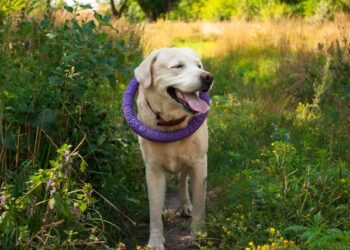Separation anxiety in dogs is a common but distressing condition where a pet experiences extreme stress when left alone. It can lead to destructive behaviors, excessive barking, and emotional distress for both the dog and the owner. Understanding the causes and implementing effective dog anxiety solutions can help create a more relaxed and independent pet.
Recognizing the Signs of Separation Anxiety
Dogs suffering from separation anxiety display various symptoms, which can sometimes be mistaken for general misbehavior. Recognizing these signs early can help in addressing the issue effectively.
Common Symptoms:
- Excessive barking, whining, or howling when left alone
- Destructive chewing on furniture, doors, or household items
- Pacing or restlessness before or after you leave
- Indoor accidents, even when fully house-trained
- Excessive drooling or panting
- Trying to escape or scratching at doors and windows
If these behaviors only occur when your dog is left alone, it is likely due to separation anxiety rather than a general obedience issue.
Causes of Separation Anxiety in Dogs
Understanding why your dog is anxious when left alone is the first step in managing it. Common causes include:
- Changes in routine: A new job, school schedule, or moving to a new home can trigger anxiety.
- Lack of socialization: Dogs that haven’t been exposed to different environments and people may struggle with being alone.
- Overattachment: Some dogs develop a deep bond with their owners, making it hard to cope with separation.
- Past trauma: Rescue dogs or those that have experienced abandonment may be more prone to separation anxiety.
Training Techniques to Reduce Anxiety
Training your dog to feel comfortable when alone is key to reducing stress and preventing destructive behaviors. Here are some effective methods:
1. Gradual Desensitization
Start by leaving your dog alone for short periods and gradually increasing the duration. This teaches them that you will always return and that alone time is normal.
2. Creating a Safe Space
Designate a cozy area where your dog feels secure. A crate, a pet bed in a quiet room, or a space with their favorite toys can help ease anxiety.
3. Establishing a Departure Routine
Avoid dramatic goodbyes and greetings. Instead, keep departures and arrivals low-key to prevent emotional spikes.
4. Using Positive Reinforcement
Reward calm behavior with treats and praise. You can also give them a treat or toy before leaving to create a positive association with your departure.
Products and Tools to Help Keep Your Dog Calm
Several products can aid in calming dogs with anxiety. Investing in the right tools can make a significant difference in their comfort and stress levels.
Interactive Toys and Treat Puzzles
Keeping your dog engaged with a treat-dispensing toy can distract them from your absence and provide mental stimulation.
Calming Aids
- Pheromone diffusers: These release calming scents that mimic natural dog pheromones.
- Weighted blankets or anxiety wraps: Products like the ThunderShirt apply gentle pressure, helping dogs feel secure.
- Calming chews or supplements: Natural ingredients like chamomile and melatonin can support relaxation.
Background Noise
Leaving the TV, radio, or white noise machine on can create a soothing environment and prevent your dog from feeling lonely.
Lifestyle Changes to Prevent and Manage Anxiety
Beyond training and products, daily habits play a crucial role in managing separation anxiety.
Increase Exercise and Mental Stimulation
A tired dog is a happy dog. Make sure your pet gets enough physical activity and mental engagement through puzzle toys, obedience training, or social interactions.
Maintain a Consistent Schedule
Dogs thrive on routine. Feeding, walking, and playtime should occur at the same times daily to create a sense of stability.
Encourage Independence
Practice leaving your dog alone in another room while you’re home. Gradually extending this time helps them get used to being alone without distress.
When to Seek Professional Help
If your dog’s separation anxiety is severe and doesn’t improve with training or calming products, consulting a professional may be necessary.
Signs Your Dog May Need Expert Support:
- Extreme panic attacks when alone
- Self-harm behaviors like excessive licking or chewing their paws
- Persistent destructive behaviors despite training efforts
A veterinarian can rule out medical conditions that might contribute to anxiety and recommend additional treatments. In more severe cases, a certified dog trainer or animal behaviorist can provide specialized training plans.
Conclusion
Separation anxiety in dogs can be challenging, but with patience, training, and the right tools, you can help your pet feel more at ease when left alone. By incorporating dog anxiety solutions such as gradual desensitization, calming products, and maintaining a consistent routine, you can create a stress-free environment for your furry friend. Remember, every dog is different, so finding the right approach takes time. Stay patient and consistent, and your pet will learn to feel more comfortable in your absence.





